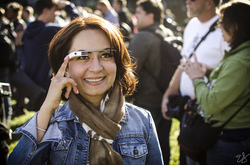Are you a wrist person or a glasses person? As we hurtle towards the post cell phone world, the next generation of trendsetters are deciding which one it's going to be. In the eyes corner, you've got Google Glass (pictured below) and others like Vuzix or Epson Moverio extolling the benefits of a hands free world where your display screen is worn like a pair of glasses. On your wrist, you've got companies like Martian, Samsung Galaxy Gear, LG's nearly ready G2, and soon to be Apple, out to prove the versatility of wearing your data on your wrist. So far, eyewear focuses on augmenting your visual reality, while wristwear serves more as a mobile phone/health fitness monitor on your wrist.
![2014-06-03-GoogleGlassWearing.jpg]()
The Rule of Screens
I wore the Martian smart wristwatch and Google Glass for a week straight while attending a conference in Africa. Hands down, the glasses got more attention. However, both of them are changing how we interact with screens. There is a rule of screens that says, "The smaller the screen, the shorter the duration you look at it." In other words you look at TV for hours at a time. You look at your smart watch or Google Glass for short glances. People look at their smart phones on average 150 times a day. I expect them to look even more when the device doesn't need to be fetched from a pocket or handbag.
Both my Google Glass and my Martian watch give you the power of your cell phone on your eyes or your wrist respectively. Glass has a camera, a display screen that dangles above your eye, a microphone for phone calls and voice, and Bluetooth connectivity to your phone. By tapping, swiping and speaking to your Google Glass, you can take photos, answer the phone, see your calendar, receive and send messages, and more.
My Martian watch (pictured below) is more the Dick Tracy variety. It looks like a wrist watch and even has an analog watch face, so it's unobtrusive and attractive. Across the bottom of the screen runs an OLED message bar that notifies me about incoming calls, texts, social media, calendar appointments and more. It also features voice commands so that you can speak to it, à la Dick Tracy, allowing you to place a call or add a memo to your calendar.
![2014-06-03-martian_watches_1.jpg]()
Same but Different
Both devices rely on a Bluetooth connection in your phone to communicate. Martian focuses on keeping you up to date on communications, while Glass is much more versatile with apps that play games, give directions, and even help you cook by looking up recipes. Both let you tuck your phone away and out of sight while staying connected.
Sex Appeal
If you want to be the center of attention, Glass is the winner. Headwear is still eye turning and implies high status and a big wallet. Glass sells for $1500; my Martian watch sells for about $249. Smartwatches are considerably more discreet and understated. The sexiest feature of the Martian watch happens when you hold your watch to your mouth and say "Call Mom." Most of the new smartwatches will be voice activated, let you know when you've got a message or calendar date, and do some degree of fitness monitoring and interaction with the web. While headware may turn heads, it's smartwatches that will get stuff done.
For Life Vlogging
Watches don't do well as well as glasses when it comes to image capture and display. Smartwatches are for getting work done and staying in touch. Many of them, like the Samsung Gear, focus on fitness monitoring. Others, like the new V. Alert, offer a one button press to text friends and family and focuses on safety, taking the place of bulky personal emergency systems.
Expense Tally
Ranging from $129 and up, a smartwatch is easy on the pocketbook. Google Glass costs $1500 and its competitors start at least $500 and up. Even kids have a line of smartwatches to call their own with Leapfrog's Leapband and Vtech's Kidizoom. Both are set to cost no more than $60.
Head Swipes Versus Button Depress
Headwear tends to rely on voice input or in the case of Google Glass, this weird swiping through commands where you brush your finger across the side of the glass frame. Martian's watch relies on pressing two buttons in on the side of the watch to cycle through the various communications commands. One makes you look like you've got a head twitch problem and the other requires a bit of Morse code to know how to elicit the proper response from the watch.
Apps to Support Environment
Whether it's a watch, a pair of glasses, or some other wearable tech, they all need apps to do something useful. Right now, Glass has a much richer apps environment while the Martian Watch is focused on a good communications experience.
Comfort
No contest. If you're running, eating, or walking, you'd rather do it with a watch on your wrist than a pair of ungainly glasses on your head.
Tale of the Tape
If you want to be the center of attention at the cocktail party, go Glass. If you want to make sure the cocktail chatter doesn't make you miss an important message, I see a smartwatch in your future.
Robin Raskin is founder of Living in Digital Times (LIDT), a team of technophiles who bring together top experts and the latest innovations that intersect lifestyle and technology. LIDT produces conferences and expos at CES and throughout the year focusing on how technology enhances every aspect of our lives through the eyes of today's digital consumer.

The Rule of Screens
I wore the Martian smart wristwatch and Google Glass for a week straight while attending a conference in Africa. Hands down, the glasses got more attention. However, both of them are changing how we interact with screens. There is a rule of screens that says, "The smaller the screen, the shorter the duration you look at it." In other words you look at TV for hours at a time. You look at your smart watch or Google Glass for short glances. People look at their smart phones on average 150 times a day. I expect them to look even more when the device doesn't need to be fetched from a pocket or handbag.
Both my Google Glass and my Martian watch give you the power of your cell phone on your eyes or your wrist respectively. Glass has a camera, a display screen that dangles above your eye, a microphone for phone calls and voice, and Bluetooth connectivity to your phone. By tapping, swiping and speaking to your Google Glass, you can take photos, answer the phone, see your calendar, receive and send messages, and more.
My Martian watch (pictured below) is more the Dick Tracy variety. It looks like a wrist watch and even has an analog watch face, so it's unobtrusive and attractive. Across the bottom of the screen runs an OLED message bar that notifies me about incoming calls, texts, social media, calendar appointments and more. It also features voice commands so that you can speak to it, à la Dick Tracy, allowing you to place a call or add a memo to your calendar.

Same but Different
Both devices rely on a Bluetooth connection in your phone to communicate. Martian focuses on keeping you up to date on communications, while Glass is much more versatile with apps that play games, give directions, and even help you cook by looking up recipes. Both let you tuck your phone away and out of sight while staying connected.
Sex Appeal
If you want to be the center of attention, Glass is the winner. Headwear is still eye turning and implies high status and a big wallet. Glass sells for $1500; my Martian watch sells for about $249. Smartwatches are considerably more discreet and understated. The sexiest feature of the Martian watch happens when you hold your watch to your mouth and say "Call Mom." Most of the new smartwatches will be voice activated, let you know when you've got a message or calendar date, and do some degree of fitness monitoring and interaction with the web. While headware may turn heads, it's smartwatches that will get stuff done.
For Life Vlogging
Watches don't do well as well as glasses when it comes to image capture and display. Smartwatches are for getting work done and staying in touch. Many of them, like the Samsung Gear, focus on fitness monitoring. Others, like the new V. Alert, offer a one button press to text friends and family and focuses on safety, taking the place of bulky personal emergency systems.
Expense Tally
Ranging from $129 and up, a smartwatch is easy on the pocketbook. Google Glass costs $1500 and its competitors start at least $500 and up. Even kids have a line of smartwatches to call their own with Leapfrog's Leapband and Vtech's Kidizoom. Both are set to cost no more than $60.
Head Swipes Versus Button Depress
Headwear tends to rely on voice input or in the case of Google Glass, this weird swiping through commands where you brush your finger across the side of the glass frame. Martian's watch relies on pressing two buttons in on the side of the watch to cycle through the various communications commands. One makes you look like you've got a head twitch problem and the other requires a bit of Morse code to know how to elicit the proper response from the watch.
Apps to Support Environment
Whether it's a watch, a pair of glasses, or some other wearable tech, they all need apps to do something useful. Right now, Glass has a much richer apps environment while the Martian Watch is focused on a good communications experience.
Comfort
No contest. If you're running, eating, or walking, you'd rather do it with a watch on your wrist than a pair of ungainly glasses on your head.
Tale of the Tape
If you want to be the center of attention at the cocktail party, go Glass. If you want to make sure the cocktail chatter doesn't make you miss an important message, I see a smartwatch in your future.
Robin Raskin is founder of Living in Digital Times (LIDT), a team of technophiles who bring together top experts and the latest innovations that intersect lifestyle and technology. LIDT produces conferences and expos at CES and throughout the year focusing on how technology enhances every aspect of our lives through the eyes of today's digital consumer.